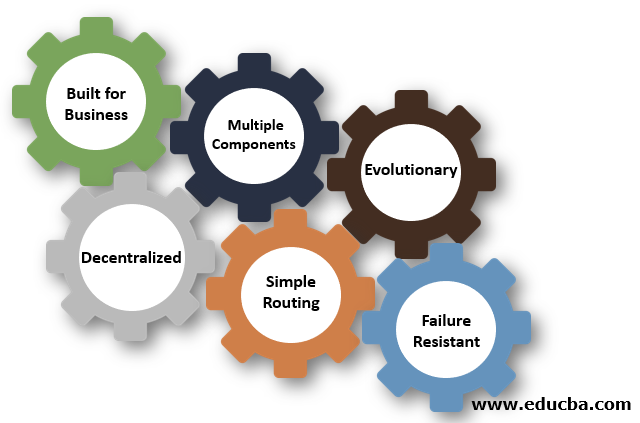
Introduction to Microservices
A software development technique to arrange all the loosely connected devices of an application into a single service is called micro services. The software is arranged in an architectural style based on service orientation. All the services are managed well and the protocol weighs light. The application is broken up into smaller parts for specialization of each part to communicate with one another through interfaces. These cross platform interfaces include APIs and REST interfaces. The application is broken down into either smaller components or services. The functions of the software is identified and isolated well in microservices.
Characteristics of Microservices
There are six types of Characteristics are as explained below:

1. Built for Business
The design of microservices generally covers company strengths and goals. The cross-functional team uses the microservices architecture in contrast to a conventional monolithic design model, in which different teams have a special focus, such as UIs, servers, technical layers, or server-side logic. That group has the responsibility to produce such products based on one or more services that are transmitted via a message bus.
2. Decentralized
Since micro-services include a range of networks and technologies, old-school central management approaches are not suitable. The micro-services group supports distributed management as its designers are working to create practical tools to solve the same problem with others. Microservice architecture favors decentralized data management, as does decentralized governance. A single logical database for various applications is used by monolithic systems. Usually, every service manages its unique database in a microservice application.
3. Multiple Components
Software designed as a micro-service can be separated into multiple component services by definition. In order to deploy, modify and then redeploy these services independently, without changing the structure of an application. As a result, one or more distinct systems can only need to be modified rather than entire applications re-deployed.
4. Simple Routing
Microservices function like a standard UNIX system, receiving requests, processing them and delivering an adequate response. This is opposed to the number of other products, such as Enterprise Service Bus, in which high technology systems are used for message, choreography, routing and business rules. You may claim that microservices have intelligent endpoints that process information and use logic and stupid pipes through which information flows.
5. Evolutionary
The evolutionary model is the Microservices architecture and again is suitable for evolutionary systems where the computer form which will one day access the application can not be completely anticipated. Many applications start on a monolithic level, but since several unforeseen requirements have arisen, microservices interacting with an older monolithic architecture can be gradually redeveloped through APIs.
6. Failure Resistant
Micro-services are designed to manage failure like a well-rounded child. Considering that a number of specific services communicate with each other, for one purpose or another a system may fail in such cases the customer should permit its surroundings to operate as gracefully as possible while bowing out. Monitoring it can nevertheless help prevent failure risk. This requirement brings to micro-services more complexity than monolithic systems architecture for obvious reasons. Popular Course in this categoryAll in One Software Development Bundle (600+ Courses, 50+ projects)600+ Online Courses | 3000+ Hours | Verifiable Certificates | Lifetime Access
4.6 (3,144 ratings)Course Price
₹8999 ₹125000
View Course
Related CoursesWindows 10 Training (4 Courses, 4+ Projects)JWS Java Web Services Training (4 Courses, 11 Projects)Java Training (40 Courses, 29 Projects, 4 Quizzes)
Pros and Cons
Below given are some Pros n Cons explained.
Pros
- The architecture of Microservice gives developers the freedom to develop and execute products independently
- A relatively small team can develop a microservice
- Simple integration and self-deployment (using open-source software like Hudson, Jenkins, etc.) Current integration.
- Easy for developing people to understand and change, a new member of the team can be quickly productive
- The developers can use the most advanced technologies.
- Start the web container faster, so that it is deployed faster
- If changes to a specific part of the application are required, the related component changed and redeployed then — no need to change the software or replaced it.
- Scale-up and convergence of services provided by third parties
- No long-term engineering stack commitment
Cons
- Testing can become complicated and repetitive due to distributed delivery.
- More services can lead to blocks of information.
- The architecture is additional complex as programmers must reduce network latency, fault tolerance and tackle a variety of message and load balancing formats.
- Increasing numbers of services can complicate integration and the management of whole products.
- In addition to several complexities of monolithic architecture, developers must address a distributed system’s further complexity.
- Developers will make more efforts to apply the interaction process between services.
- The management of cases involving more than one company without the use of centralized transactions is not only complicated but requires communication and cooperation between teams.
Frameworks for Java Microservice
Following are the frameworks of java microservice:
- Spring Boot: This is probably the best Java microservices system that operates on top of the control reversal languages, oriented programming, etc.
- Dropwizard: Dropwizard integrates robust, mature Java libraries in a simple, light-weight bundle that focuses on making things happen in Dropwizard.
- Restlet: The Restlet Project assist Java developers in building better REST system Web APIs.
- Spark: A micro-framework to build web applications with minimal effort in Kotlin and Java 8.
Conclusion
Here we have seen what microservices are and how they can help you develop the architecture of your business. We covered their main benefits after identifying what those programs were. Instead, we have seen some of the best known Java microservice APIs.
Recommended Articles
This has been a guide to What is Microservices? Here we discuss the introduction, characteristics, pros and cons with frameworks of java microservices. You may also have a look at the following articles to learn more –
